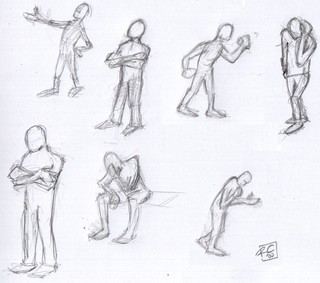Examples of Communication
1. Human speech
Speech is a natural form of communication for human beings, and computers with the ability to understand speech and speak with a human voice are expected to contribute to the development of more natural man-machine interfaces. Computers with this kind of ability are gradually becoming a reality, through the evolution of speech synthesis and speech recognition technologies. However, in order to give them functions that are even closer to those of human beings, we must learn more about the mechanisms by which speech is produced and perceived, and develop speech information processing technologies that make use of these functions. We use speech every day almost unconsciously, but an understanding of the mechanisms on which it is based will help to clarify how the brain processes information and will also lead to the development of more human-like speech devices through the imitation of these functions by computers.
2. Body Language
Body Language - technically known as kinesics (pronounced 'kineesicks') - is a significant aspect of modern communications and relationships.
Body Language is therefore very relevant to management and leadership, and to all aspects of work and business where communications can be seen and physically observed among people.
Body language is also very relevant to relationships outside of work, for example in dating and mating, and in families and parenting.
Communication includes listening. In terms of observable body language, non-verbal (non-spoken) signals are being exchanged whether these signals are accompanied by spoken words or not.
Body language goes both ways:
- Your own body language reveals your feelings and meanings to others.
- Other people's body language reveals their feelings and meanings to you.
The sending and receiving of body language signals happens on conscious and unconscious levels.
3. Gesture
Gestures are a form of nonverbal communication in which
visible bodily actions are used to communicate important messages, either in
place of speech or together and in parallel with spoken words. Gestures include
movement of the hands, face, or other parts of the body. Physical non-verbal
communication such as purely expressive displays, proxemics, or displays of
joint attention differ from gestures, which communicate specific messages.Gestures
are culture-specific and can convey very different meanings in different social
or cultural settings.Gesture is distinct from sign language. Although some
gestures, such as the ubiquitous act of pointing, differ little from one place
to another, most gestures do not have invariable or universal meanings but
connote specific meanings in particular cultures. A single emblematic gesture
can have very different significance in different cultural contexts, ranging
from complimentary to highly offensive.
4. Sign
A sign is understood as a discrete unit of meaning in
semiotics. It is defined as "something that stands for something, to
someone in some capacity" It includes words, images, gestures, scents,
tastes, textures, sounds – essentially all of the ways in which information can
be communicated as a message by any sentient, reasoning mind to another. The
nature of signs has long been discussed in philosophy. Initially, within
linguistics and later semiotics, there were two general schools of thought:
those who proposed that signs are ‘dyadic’ (i.e. having two parts), and those
who proposed that signs are interpreted in a recursive pattern of triadic (i.e.
three-part) relationships.










No comments:
Post a Comment